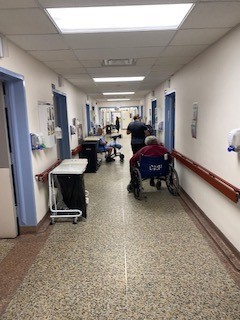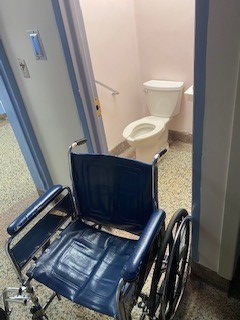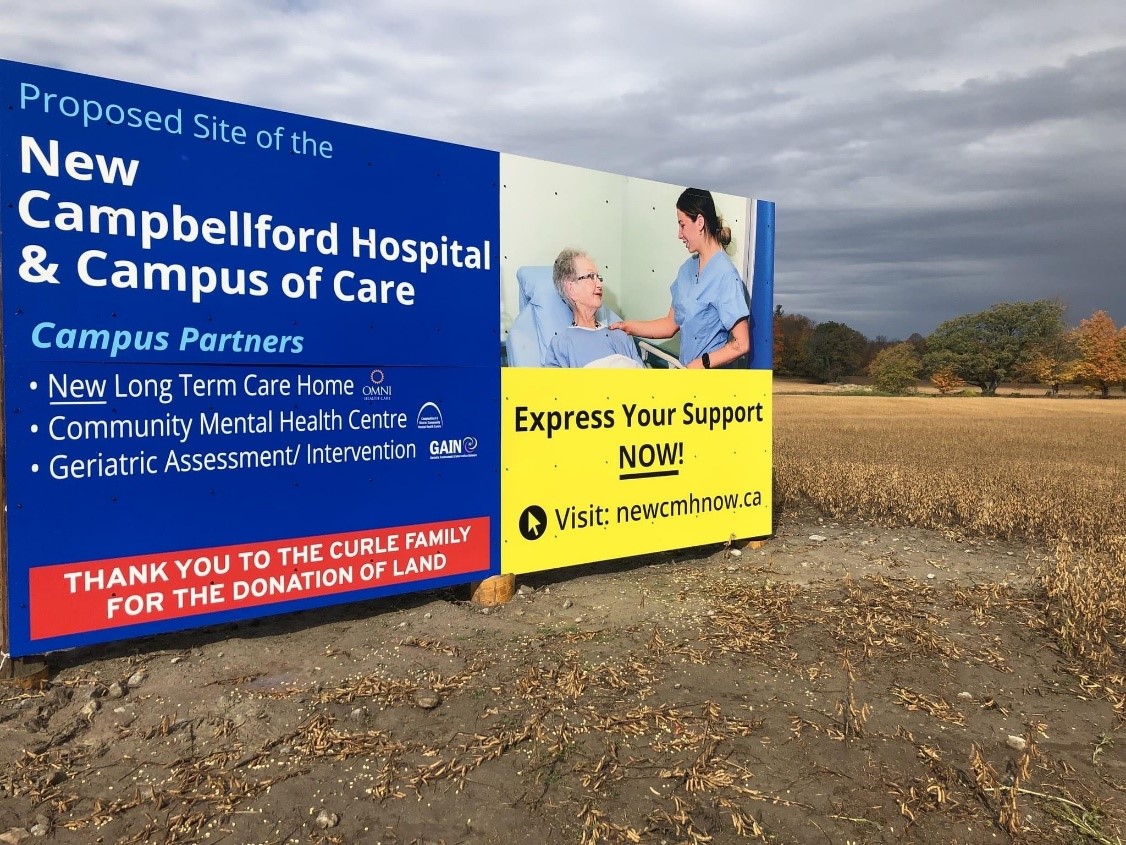Havelock resident Richard Beatty is no stranger to the Campbellford Memorial Hospital (CMH). And after four stays as an inpatient, he is confident that the 70+-year-old facility—with its small patient rooms, crowded hallways, and inaccessible spaces—is not keeping pace with modern health care and the community's needs.
In 2020, Richard had an unfortunate fall down the stairs, cracked a couple of ribs, and broke his arm, leading to a three-week stay in CMH.
"This particular stay was in a semi-private room, but with two beds, two tray tables, two chairs, and my walker, it was almost impossible to stand up to make my way to the washroom," shared Richard. "There was no privacy when I had visitors or when my doctors came to talk to me about my treatment or test results."
His wife, Robbie, added that the crowded room made it difficult to engage as a caregiver: "I felt limited in the amount of time I could spend with Richard because the space was so cramped, and there was no place really to sit comfortably. Everyone tried to do their best, but it was very frustrating from a patient and family member perspective."
One of the reasons for Richard's extended hospital stay was inpatient physiotherapy support to gain the mobility and strength to return home safely.
Richard explained: "Because of my fall, I had a walker, and there wasn't enough clearance to get the walker out of the room. Part of my physiotherapy was to walk the corridors. But to do so, the physiotherapy team had to bring a wheelchair to me so they could take me to the corridor where I would transfer to a walker."
For Richard, it is evident the current inpatient floors cannot support modern healthcare delivery: "It's a 70-year-old hospital, and there is so much new equipment that wasn't around in the 1950s. There just isn't room. Even the corridors were full of wheelchairs and equipment that I constantly had to skirt around while walking. It was almost like a maze."
The infrastructure is failing patients
The CMH Team echoes Robbie and Richard's concerns about how the limited space affects accessibility, privacy, safety, and comfort.
As a rural hospital, CMH serves a predominantly geriatric inpatient population. In 2023-24, nearly 80% of CMH's admitted patients were 65 and older, and 29% were 85 and older. The focus on providing inpatient care to older adults only exacerbates the concerns about the physical space. Randi Williams, the Behavioural Supports RN for admitted patients at CMH, experiences first-hand the stress the physical environment has on many patients and families.
At the top of Randi's list of concerns are the crowded corridors, inaccessible washrooms, lack of tub rooms, cramped patient rooms, and absence of a patient dining room and activities room (especially for alternate level of care patients).
"The layout of the first floor makes it really hard if a patient needs to walk the hallways safely as part of their rehabilitation or to prevent deconditioning," shared Randi. "We don't have adequate storage, so our medical supplies are in the hallway, which is a risk of tripping. In addition to the roadblocks, the layout doesn't allow for continuous walking."
The inadequate bathing and washroom facilities also have a significant effect on patients.
"Our bathrooms are dated and small, so trying to help someone maximize their capabilities is really hard in a tight space," said Randi. "Further to that, we don't have a tub room, and the one shower room we do have is not a welcoming space that feels safe for someone – especially for a patient with a cognitive impairment."
Randi added: "Usually, I support patients exhibiting responsive behaviours, and I do find that sometimes it's the environment that is not conducive to providing support in a way that is best for them. So that's why I'm getting the referral, and those things are difficult to change."
Heather Campbell, Vice President, Patient Care, and Chief Nursing Executive, profoundly understands the facility's numerous challenges to patients, families, and staff. "Our inpatient floors were developed in the 1950s when ward rooms were the standard, leaving us a limited number of private rooms. As a result, the facility became a significant vulnerability during COVID-19 because it made it challenging to adhere to isolation protocols when there was a patient with an infectious disease or an outbreak on the unit. We urgently need to improve our ability to create safe spaces to protect our patients from disease transmission."
The community in critical need of a redeveloped CMH
As part of a Campus of Care, a new hospital can create an inpatient unit that matches the comprehensive needs of the older patient population in the Campbellford area.
The redeveloped inpatient area will create a larger, safer space for patients who need mobility assistance, such as accessible washrooms and bathing facilities, bigger patient rooms, and space at the bedside for medical equipment to promote independence. The appropriately sized rooms will also allow a comfortable and welcoming space for family visiting and involvement in their loved one's care.
Randi noted that because the rural hospital serves a geriatric population, there is a need to build a sense of community that will lead to better health outcomes.
"I think that a dining area is key. It would allow one staff member to watch and support a group of patients eating, and it also gives them a sense of purpose to get up, and that's what they're used to doing – you don't eat in bed. Additionally, the new hospital would allow us to have an activities room for social, recreation, and rehab programming."
Heather added: "Our patients, families, and staff make do with our facilities, but we need a modern inpatient area that accommodates modern technology and current best practices so that we can deliver the best possible health outcomes for our community."
CMH has applied for a capital planning grant to redevelop the hospital as part of an Integrated Campus of Care that would create one location for a continuum of health services for residents. The redevelopment project would bring together the hospital, long-term care, affordable senior housing and services, mental health, primary care, and other healthcare services. CMH's application for a capital planning grant to build a campus of care is pending approval from the Ministry of Health.

